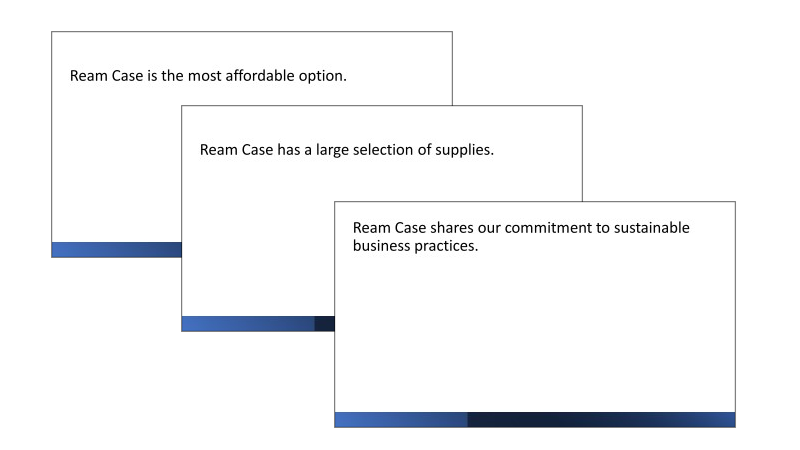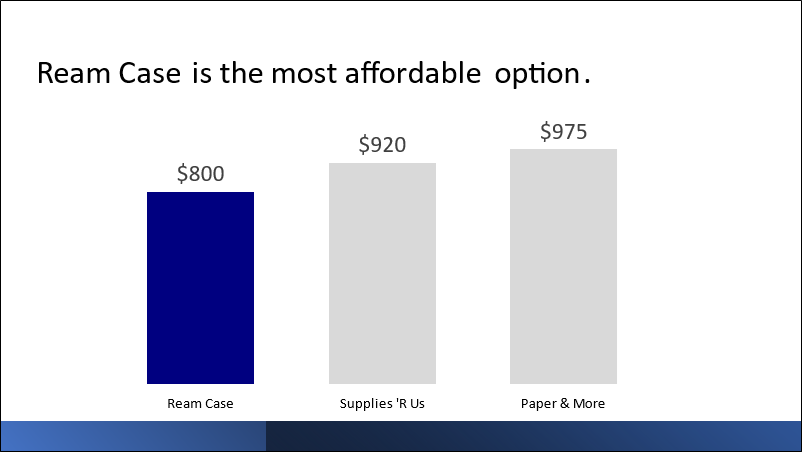Putting it into Practice
If you are like most people, the evidence-driven competency will be one of the most difficult competencies to develop and master. It requires you to examine potential evidence and determine what will be the most compelling support for your claims; communicate that evidence through a mix of text, numbers, and visualizations; and cite the sources of your evidence in ways that support your credibility.
The strategies we share in this chapter are only the tip of the proverbial iceberg when it comes to being evidence-driven. As you get more experienced and as you become more embedded in a particular organization or industry, you certainly will learn additional strategies for presenting evidence. And chances are that future technological developments and advances in the data analytics field may generate even more options for communicating evidence.
One recent advance in communicating evidence is a different approach to designing presentation slide decks called Assertion-Evidence Slide Design. By following its principles, you can create powerful and memorable business presentations.
Message Strategy: Designing Assertion-Evidence Slide Decks
Steve Jobs once stated, “People who know what they’re talking about don’t need PowerPoint.” Yet, conventions often dictate that business communicators should provide visual aids. So, that means that slide decks are likely here to stay.
But the problem with slide decks is that they are often really boring. In particular, PowerPoint was originally designed with only one kind of data visualization in mind: the list. You have probably seen countless numbers of these kinds of presentations as a student. They have a title on each slide, a bulleted list, and maybe an image for interest.
Given that there are ways to present evidence in more effective and compelling ways, why stick with just lists in presentations? In this message strategy chapter, you will learn how to dramatically improve your slide decks with a relatively new approach called Assertion-Evidence Structure.
The Assertion-Evidence Structure is an approach to designing slide decks that was developed by Michael Alley, an expert in engineering communication.[1] While it started out as an approach in engineering and science, its basic principles apply equally well to business presentations.[2]
The basic premise of Assertion-Evidence structure is that it replaces boring and ineffective traditional slide decks with a more flexible format that has two key components on every slide: (1) a concise assertion (or claim or point) supported by (2) visual evidence.
The Assertion-Evidence Structure has several benefits. First, research has demonstrated that Assertion-Evidence slides are easier to comprehend because each slide presents one clear idea. Second, Assertion-Evidence slides are remembered longer because they tap into both visual and auditory brain processing. Third, receivers find Assertion-Evidence slides more visually appealing and engaging.
There are also some indirect benefits of Assertion-Evidence slide decks. Often, business communicators gain more clarity about their main ideas and evidence simply by developing their slide decks with Assertion-Evidence principles in mind. Also, because slides usually have very little text, business communicators are no longer tempted to read slides to their audiences and will, in fact, be more engaged with their receivers. It shouldn’t come as a surprise then that when Assertion-Evidence slides are done well, perceptions of the speakers’ professionalism and credibility are boosted.
Creating an Assertion-Evidence slide deck does take some creativity and deep thinking. Below are the steps.
Write an Assertion for Each Slide
Once you have your overall plan in place for your presentation, it is time to create individual slides that support each point. For each slide, write one complete sentence that clearly states your point or claim. Even if the assertion is large in font size, it should fit in one or two lines of text. Perhaps most importantly, each slide should have one and only one assertion.
In the following example, a traditional PowerPoint list-style slide containing three claims is transformed into three separate Assertion-Evidence slides.
Traditional Format:
Slide 1:
Ream Case Benefits
-
- Affordable
- Large selection
- Sustainability promise
Assertion Format:
Slide 1: Ream Case is the most affordable option.
Slide 2: Ream Case has a large selection of supplies.
Slide 3: Ream Case shares our commitment to sustainable business practices.
Select Visual Evidence for Each Assertion
The next step is to choose some sort of visual evidence that supports each claim. Visual evidence can include any kind of data visualization (charts, tables, graphs, maps), but it can also include things like photographs, icons, flow charts, diagrams, illustrations, cartoons, clip art, and more. There are two things to keep in mind when selecting visual evidence. First, visual images are no longer just for decoration. They are part of the core message. That means you must choose visual evidence that directly supports each claim. Second, you need to apply all the principles you learned about effective data visualization.
Returning to the example, we can look at the claim “Ream Case is the most affordable option.”
Weak Visual Evidence: Ream Case’s company logo. It is weak because it does not say anything about affordability.
A photograph or clip art image of money. Even though money has something to do with affordability, it doesn’t actually visualize anything about Ream Case’s affordability.
Acceptable Visual Evidence: A screenshot of Ream Case’s “Low Cost Guarantee” webpage. This image connects Ream Case with affordability, but it doesn’t show that they are the most affordable.
Strong Visual Evidence: A chart that compares price quotes of Ream Case and the other competitors. This image directly illustrates that Ream Case is more affordable.
Add Citations, if Necessary
If you use images that someone else created, you should cite the source. Doing so not only gives credit to the source but also builds your credibility. One approach to citing slides in a slide deck is to provide an abbreviated citation in the lower corner of the slide.
Example: “The Science of Strong Business Writing,” Harvard Business Review, 2021
SAMPLE ASSERTION-EVIDENCE SLIDE DECK
Traditional slide. Contains a text-based list and clip art.

Assertion. Each claim is written as a complete sentence, with one sentence per slide.

Assertion-Evidence. Every assertion is paired with visual evidence that directly supports the claim.

- For more information about the development of the Assertion-Evidence Structure, you can read Michael Alley, The Craft of Scientific Presentations, 4th ed. (New York, NY: Springer, 2018). You can also check out his website at https://www.assertion-evidence.com/ ↵
- You can watch a video tutorial on Assertion-Evidence slide design by the late business professor Robert Yale at https://www.youtube.com/watch?v=xNW84FUe0ZA ↵
a debatable statement that you attempt to make other people accept or understand (same as "point")
see "claim"
the material used to support the probable truth of claims
